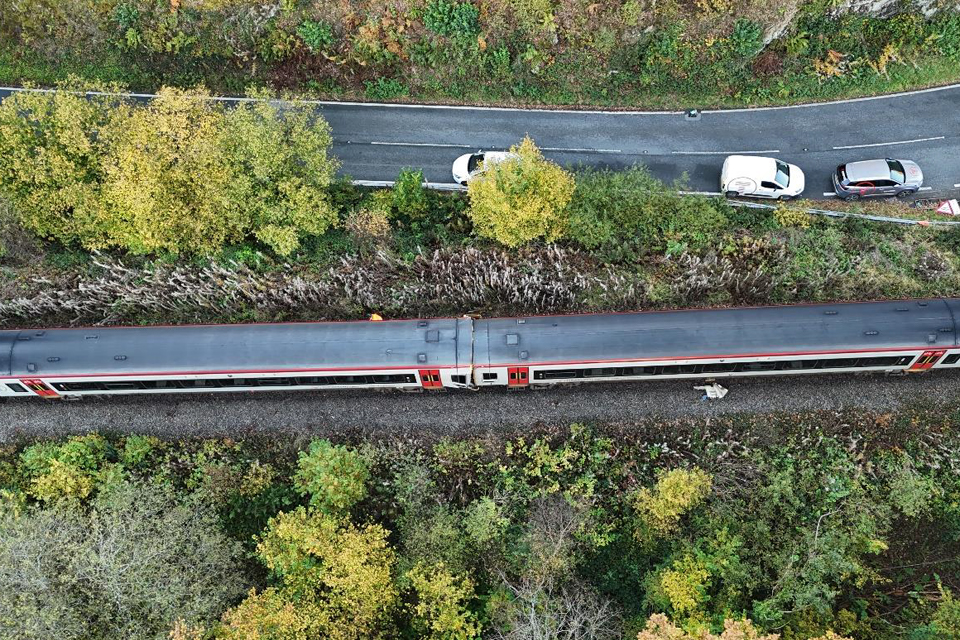Rail Accident Investigation Branch

class="gem-c-govspeak govuk-govspeak gem-c-govspeak--direction-ltr govuk-!-margin-bottom-0">
At around 19:26 on Monday 21 October 2024, train 1J25, the 18:31 Transport for Wales passenger service from Shrewsbury to Aberystwyth, collided with train 1S71, the 19:09 Machynlleth to Shrewsbury passenger service, also operated by Transport for Wales.
The collision took place on Network Rails Cambrian line, approximately 900 metres west of the passing loop located at Talerddig, Powys. One passenger died and four other people were seriously injured. Eleven more people sustained injuries which required hospital treatment. Neither train derailed in the collision, although significant damage was caused to the leading vehicles of both trains.

Aerial view of the accident site train 1S71 is shown on the left of picture and train 1J25 on the right.
RAIB was notified at 19:45 on the night of the accident and immediately dispatched a team of inspectors to the scene. Over the next few days, RAIB worked in conjunction with the British Transport Police, the Office of Rail and Road and the railway companies involved to secure the necessary evidence to support our independent safety investigation.
RAIB released the site of the accident to Network Rail on the evening of Wednesday 23 October 2024, to allow for inspection and repair of the track, and recovery of the trains. Both trains were moved off site on Friday 25 October 2024. RAIB inspectors and support staff continued to secure evidence at the site of the accident, and at nearby locations, until Saturday 26 October 2024.
Both trains involved in the accident were 2-car class 158 diesel multiple units. These units are fitted with wheel slide protection systems, similar in function to anti-lock braking systems on road vehicles, and an automatic sanding system, which discharges sand automatically via sanding hoses when wheel slide is detected during braking. This is intended to increase the available friction at the wheel/rail interface.
The Cambrian line is equipped with the European Rail Traffic Management System, a form of railway signalling. This system removes the need for lineside signals by transmitting signalling and control data directly to the train. The limits of each section of track controlled by the system are signified by reflective lineside signs known as block markers.
The railway approaching Talerddig from each direction consists of a single track. To allow trains to pass each other there, a loop is provided. This has points at each end which allow trains to enter a short length of track adjacent to the single line. Westbound trains climb an ascending gradient to enter the loop and, on exiting, rejoin the single track as it descends towards Llanbrynmair and Machynlleth.
RAIBs preliminary examination has found that westbound train 1J25 had been due to stop in the loop at Talerddig to allow eastbound train 1S71 to pass. Initial analysis of data from the on-train data recorder (OTDR) fitted to train 1J25 shows that the driver applied service braking to slow the train as it neared the loop at Talerddig. Around 40 seconds after the first service brake application, the OTDR records an emergency brake demand being made. This emergency brake demand remained in place until the collision. OTDR data shows that wheel slide started during service braking and was constant during emergency braking.
Train 1J25 then entered the loop at Talerddig. Although the train slowed while passing through the loop, it did not stop before passing the block marker positioned near the exit. The train subsequently exited the loop, rejoined the single line, and continued to travel for around 900 metres on the descending gradient, before colliding with train 1S71.
There is conflicting evidence relating to the speed of the trains at the point of collision. Initial analysis indicates that train 1J25 was travelling at between 24 km/h (15 mph) and 39 km/h (24 mph), while train 1S71 was travelling at around 10 km/h (6 mph) in the opposite direction. RAIB is continuing to analyse evidence relating to the collision speed, which remains an area of ongoing investigation.
Following the accident, RAIB undertook measurements of wheel/rail adhesion levels at various locations from the approach to Talerddig loop to the point of collision. These found levels of wheel/rail adhesion that were low.
An inspection of the automatic sanding system fitted to train 1J25 after the accident showed that the sanding hoses on the leading vehicle of this train (which would have been active at the time of the accident) were blocked and apparently unable to discharge sand.
Our investigation will seek to identify the sequence of events which led to the accident. It will also consider:
- the actions of those involved and any factors that may have influenced them
- the level of wheel/rail adhesion present from the approach to Talerddig loop to the point of collision
- the status and performance of the braking, wheel slide protection and sanding systems on train 1J25
- the behaviour of both trains during and following the collision
- Transport for Wales policies relating to low wheel/rail adhesion and how it managed the risk of low adhesion on the Cambrian line
- Network Rails policies relating to low wheel/rail adhesion and how it managed the risk of low adhesion on the Cambrian line
- the processes used to assess and control the risk of overrun on the Cambrian line
- any relevant underlying factors, including any actions taken in response to previous relevant safety recommendations.
Our investigation is independent of any investigation by the railway industry, the British Transport Police or by the industrys regulator, the Office of Rail and Road.
We will publish our findings, including any recommendations to improve safety, at the conclusion of our investigation. This report will be available on our website.
You cansubscribeto automated emails notifying you wh
